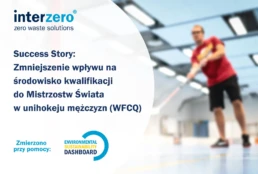Reducing the environmental impact of the Men's World Floorball Championship Qualification (WFCQ)

Introduction: In recent years, the global discussion on sustainability has intensified, prompting organisations around the world to assess their environmental impact. At the forefront of this movement, our team undertook a comprehensive analysis of the environmental impact of the Men's World Floorball Championship Qualifier (WFCQ). Using Environmental Sustainability Dashboard (ESD) developed by Interzero, we set out to assess and reduce the carbon footprint of this major sporting event.
Context: The qualification for the World Floorball Championships (WFCQ) took place in Škofja Loka, Slovenia, from 31 January to 4 February 2024. Five teams from Slovenia, Belgium, Switzerland, Italy and Denmark took part, as well as representatives from the International Floorball Federation (IFF). A total of 216 people took part in the tournament, including players and staff, 2,453 visitors, 33 volunteers and local labour.
Challenge: Carbon footprint of the WFCQ venue
The challenge was clear: how could we ensure that the men's WFCQ, while an exciting show of athleticism and sporting competition, was also consistent with our commitment to sustainability? Given the many dimensions, including venue operations, transport logistics, communication activities, exhibition preparation, accommodation and catering services, the task was daunting. However, armed with a dedicated team and our Environmental Sustainability Dashboard, we rose to the challenge.
The WFCQ was held throughout the event at the Poden Arena, located in Škofja Loka (Slovenia).

The following impact categories were considered to calculate the greenhouse gas emissions associated with the facility:
- Stationary fuel combustion.
- Overall electricity consumption.
- Network heat/cold consumption.
- Water consumption.
- Waste disposal.
Solution: Our methodology was rooted in the principles of life cycle assessment (LCA), ensuring that every aspect of the event was meticulously examined for its environmental impact. From quantifying greenhouse gas emissions to assessing waste generation and transport. Using the Environmental Sustainability Dashboard platform, we were able to collect and analyse data from a variety of sources, in line with internationally recognised standards such as the Global Reporting Initiative (GRI).
Results: The results of our analysis were both informative and useful. With a total carbon footprint of 108.1 tonnes of CO2 equivalent, we gained valuable insight into the areas where our efforts can make the most difference. Transport emerged as the most influential dimension, accounting for 52% of the event's carbon footprint, mainly due to air travel. This was followed by accommodation and catering, each of which contributed significantly to overall emissions.
However, armed with this knowledge, we did not stop at mere assessment. Instead, we proposed targeted strategies to reduce environmental impact. From promoting sustainable travel options for participants to optimising the facility's energy consumption and minimising waste generation, each mitigation measure was driven by our commitment to sustainability.
At the end of the men's WFCQ, we not only achieved our goal of quantifying the event's environmental impact, but also demonstrated our unwavering commitment to sustainability. Through collaborative efforts and innovative solutions, we transformed the sporting event into a beacon of environmental responsibility, setting a new standard for future championships around the world.
In conclusion, the success of our sustainability initiative for the men's WFCQ is a testament to the power of data-driven decision-making and collective action. Looking to the future, we remain committed to continuing our sustainability efforts, ensuring that future generations can enjoy the thrill of sport without compromising the health of our planet.
What is the Environmental Sustainability Dashboard?
Environmental Sustainability Dashboard (ESD) is Interzero's solution to help clients integrate sustainability into their business strategy. ESD consists of several steps, from context analysis to the creation of a Sustainability Action Plan. Among these steps, a key element is the ESD tool, an online platform designed to help companies calculate the various environmental, social and managerial impacts associated with their core business and/or products.
The impact assessment takes into account various dimensions such as emissions, energy, materials, water and waste. A wide range of key performance indicators (KPIs) can be calculated, such as greenhouse gas emissions or carbon footprint. For each dimension, specific data are required to calculate the corresponding set of results. Both input and output data are selected and generated based on commonly used standards, such as the Global Reporting Initiative, and literature.
The output can be used not only for communication purposes, but also for technical evaluation and can be integrated by the company into its sustainability report. ESD is suitable for companies of all sizes, whether they offer services or products.